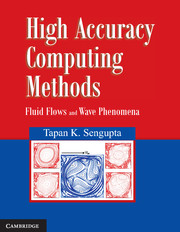Book contents
- Frontmatter
- Contents
- Foreward
- Preface
- Chapter 1 Basic Ideas of Scientific Computing
- Chapter 2 Governing Equations in Fluid Mechanics
- Chapter 3 Classification of Quasi-Linear Partial Differential Equations
- Chapter 4 Waves and Space–Time Dependence in Computing
- Chapter 5 Spatial and Temporal Discretizations of Partial Differential Equations
- Chapter 6 Solution Methods for Parabolic Partial Differential Equations
- Chapter 7 Solution Methods for Elliptic Partial Differential Equations
- Chapter 8 Solution of Hyperbolic PDEs: Signal and Error Propagation
- Chapter 9 Curvilinear Coordinate and Grid Generation
- Chapter 10 Spectral Analysis of Numerical Schemes and Aliasing Error
- Chapter 11 Higher Accuracy Methods
- Chapter 12 Introduction to Finite Volume and Finite Element Methods
- Chapter 13 Solution of Navier–Stokes Equation
- Chapter 14 Recent Developments in Discrete Finite Difference Computing
- Exercises
- References
- Index
Chapter 8 - Solution of Hyperbolic PDEs: Signal and Error Propagation
Published online by Cambridge University Press: 05 January 2014
- Frontmatter
- Contents
- Foreward
- Preface
- Chapter 1 Basic Ideas of Scientific Computing
- Chapter 2 Governing Equations in Fluid Mechanics
- Chapter 3 Classification of Quasi-Linear Partial Differential Equations
- Chapter 4 Waves and Space–Time Dependence in Computing
- Chapter 5 Spatial and Temporal Discretizations of Partial Differential Equations
- Chapter 6 Solution Methods for Parabolic Partial Differential Equations
- Chapter 7 Solution Methods for Elliptic Partial Differential Equations
- Chapter 8 Solution of Hyperbolic PDEs: Signal and Error Propagation
- Chapter 9 Curvilinear Coordinate and Grid Generation
- Chapter 10 Spectral Analysis of Numerical Schemes and Aliasing Error
- Chapter 11 Higher Accuracy Methods
- Chapter 12 Introduction to Finite Volume and Finite Element Methods
- Chapter 13 Solution of Navier–Stokes Equation
- Chapter 14 Recent Developments in Discrete Finite Difference Computing
- Exercises
- References
- Index
Summary
Introduction
In Chapter 3 we have noted that hyperbolic PDEs are characterized by the presence of real lines along which the highest order derivatives appearing in the differential equations are discontinuous; these lines are the characteristics. Along the characteristics, information propagates for hyperbolic equations. Thus, accurate solution of hyperbolic PDEs is related to the central problem of correctly allowing the signal/disturbance to propagate, as given by the governing PDE. For other classes of differential equations (parabolic or elliptic PDEs) describing equilibrium state of dynamical systems can also support disturbances which can be posed as wave propagation problems. Such wave propagation problems are decided by the dispersion relation relating spatial and temporal scales (as described in Chapter 4 for some mechanical systems) and resultant waves are termed as dispersive waves.
Thus, we discuss about solution methods for hyperbolic PDEs, while focussing on propagating signals and numerical errors. Although, we discuss only about a few handful classical methods of solving hyperbolic PDEs, our attention is equally on the most important problem of signal and error dynamics from a numerical perspective. We would, however, emphasize on signal and error propagation in this chapter, noting that the celebrated error analysis due to von Neumann [41, 53] has been corrected in [259] with respect to a specific example drawn from hyperbolic equation. This forms the second part of this chapter, where the analysis is for identifying mechanisms and sources of numerical error which is independent of which method is being employed.
Information
- Type
- Chapter
- Information
- High Accuracy Computing MethodsFluid Flows and Wave Phenomena, pp. 130 - 149Publisher: Cambridge University PressPrint publication year: 2013
